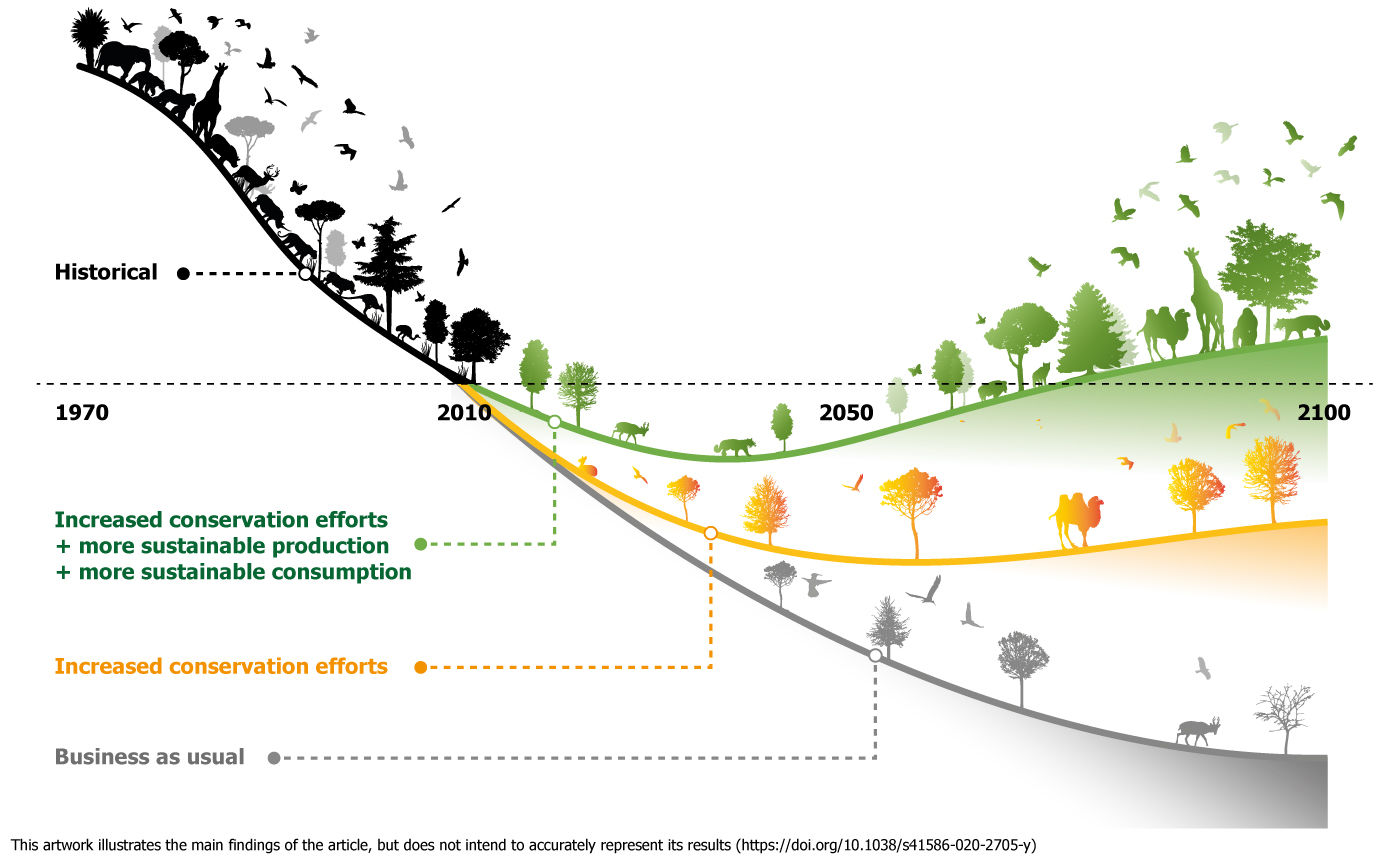News
Strategy for halting and reversing biodiversity loss revealed

News | Sep 2020
A team of world-leading scientists have identified the 6 key actions needed to bend the curve of terrestrial biodiversity loss caused by land use change.
In a study published today in Nature, ground-breaking modelling and newly developed scenarios show that it could be possible by 2050 to halt and reverse terrestrial biodiversity loss caused by land use change.
This requires an ambitious, integrated strategy combining the following conservation action and changes to food systems, alongside wider sustainability efforts including on climate change:
- Sustainable increases in crop yields.
- Trade increases in agricultural goods with reduced trade barriers.
- Reducing the waste of agricultural goods from field to fork by 50%.
- Cutting the share of animal calories in human diets by 50%[1].
- Increasing Protected Area extent to 40% terrestrial coverage, covering important sites for biodiversity and with improved management.
- Increasing restoration (reaching about 8% of terrestrial areas by 2050) and landscape-level conservation planning that balances production and conservation objectives on all managed land.
Today, over 1 million animal and plant species are threatened by extinction and many of the world’s ecosystems are at risk of collapse. In this major study led by the International Institute for Applied Systems Analysis (IIASA), involving 58 experts from across 46 institutions including UNEP-WCMC, scientists use futures modelling to consider seven different scenarios to explore how we can bend the curve on biodiversity loss from habitat conversion and feed a growing population.
The study projects that without further efforts to tackle habitat loss and degradation, global biodiversity decline will continue at a rate close to or greater than that for 1970-2010.
“We wanted to assess in a robust manner whether it might be feasible to bend the curve of declining terrestrial biodiversity due to current and future land use, while avoiding jeopardizing our chances to achieve other Sustainable Development Goals (SDGs),” explains study lead author and IIASA researcher David Leclère. “If this were indeed possible, we also wanted to explore how to get there and more specifically, what type of actions would be required, and how combining various types of actions might reduce trade-offs among objectives and instead exploit synergies.”
The research shows that a bold conservation plan is crucial alongside other actions to halt terrestrial biodiversity declines and set ecosystems onto a recovery path. However, modelling suggests that the conservation and restoration measures alone would not be enough to bend the curve of biodiversity loss from habitat conversion by 2050 and could fail to prevent almost 50% of projected baseline losses caused by land use change. Further, without transformation of the food system, bolder conservation efforts would conflict with future food provision by raising food prices.
The study finds that to stop and reverse terrestrial biodiversity decline before 2050 and reduce potential negative impacts on food security, conservation efforts should be combined with simultaneous transformation of food systems, as well as wider action on other drivers of biodiversity loss, such as climate change and biological invasions.
By combining the 6 actions listed above in an integrated scenario, modelling shows that biodiversity loss from habitat conversion is halted by 2050 and is followed by recovery. In this case, more than two thirds of future terrestrial biodiversity losses caused by land use change are avoided.
Neil Burgess, Chief Scientist, UN Environment Programme World Conservation Monitoring Centre (UNEP-WCMC), contributing author of the study, says:
“This is the first time that the key combined actions needed to potentially stop biodiversity loss on land by 2050 have been identified and backed by robust futures modelling. This research sets out clear and ambitious actions for governments, businesses, and consumers to take on board as we work together to tackle the global nature crisis.”
Such transformative change in food and land use systems would also make a large contribution to ambitious climate mitigation targets, reduce pressure on water resources, and provide health benefits.
These findings have direct implications for international environmental policy. The next meeting of the Convention on Biological Diversity (CBD) in 2021 is expected to agree a post-2020 global biodiversity framework: a set of new international goals and targets for the next decade.
This study finds that bold conservation efforts and food system transformation are central to an effective post-2020 biodiversity strategy. These efforts will require unprecedented ambition and coordination, and concerted leadership from around the world.
Neville Ash, Director, UNEP-WCMC, says:
“The post-2020 global biodiversity framework will be a critical opportunity to stop biodiversity loss and ensure that people continue to benefit from biodiversity. This research is a significant contribution to its development and delivery and shows the importance of coupling bold conservation measures with transformation of food systems to tackle the drivers of biodiversity loss.”
Read the full study here.
[1] except in regions in which the share of animal products in diets is already estimated to be low (the Middle East, sub-Saharan Africa, India, Southeast Asia and other Pacific Islands).
Have a query?
Contact us
communications@unep-wcmc.org
